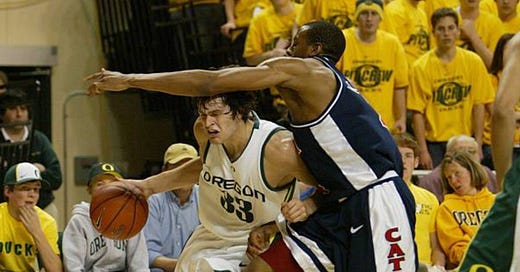Arizona-Oregon Deliver on A Bittersweet Reunion
The 2025 NCAA Tournament opening weekend ended with a terrific game and sad reminder of what conference realignment has done to college basketball.
Andy Katz shared an anecdote during the East Region 2nd Round matchup between Arizona and Oregon about the night Ducks swingman Luke Jackson went off for 42 points against the Wildcats in 2004. It was the most an Oregon player ever scored at college basketball’s original version of The Pit1, McArthur Court — but not enough to overcome 37 points from Portland native and Arizona legend Salim Stoudamire.
TNT’s telecast of UA’s 87-83 win to advance in the 2025 edition of March Madness dedicated considerable time to celebrating the history of the Ducks-Wildcats rivalry, which added a thrilling new chapter.
Now, rivalry carries multiple definitions in the context of sports. I have learned in my time as a sports writer that college football fans are especially touchy about its application, having once been inundated with feedback from readers taking exception to me deeming USC vs. Stanford a rivalry.
Basketball fans, by and large, seem to have a less rigorous standard — for the most part. Plenty of UCLA supporters I have encountered assert that the Bruins have no rivalry with Arizona, since UA’s one national championship comes nowhere near the 11 the Sons of Westwood claim.
Most Arizona fans consider UCLA the program’s primary basketball rival, however, and several players and coaches spanning multiple generations from both sides of the rivalry deem it such.
College Basketball is Better with a Strong Arizona-UCLA Rivalry
Third-ranked Arizona visits Pauley Pavilion and No. 7 UCLA on Tuesday in the first of two meetings between the two in a nine-day span, and college basketball really couldn’t ask for a better series to usher in February.
The reason is that the two programs were consistently the standard-bearers of the Pac-10/12 Conference for 40 years. To that end, rivalry in basketball comes more from competition than pure animus, and that is why hoopheads tend to be less sensitive about what is and isn’t deemed a rivalry than their gridiron counterparts.
Case in point: the natural venom that exists between Arizona and Arizona State doesn’t disappear when the Wildcats and Sun Devils meet on the hardwood. However, football’s Duel in the Desert for the Territorial Cup is a marquee event no matter the teams’ records in a given season.
Because Arizona State basketball was rarely near Arizona’s level in the Pac-10/12 years, the Wildcats’ battles for conference supremacy against UCLA made the Bruins their chief rivals.
In the same regard, the old Pacific Conference offered a number of generational rivalries through eras depending on which teams were in regular contention. Stanford became a rival of Arizona’s in 1988 when the Mike Montgomery-coached Cardinal knocked off the then-No. 1-ranked Wildcats, beginning Maples Pavilion’s reputation as the West’s toughest place to play into the 2000s.
Washington’s emergence in the late 1990s, peaking with the outstanding backcourt of Nate Robinson, Brandon Roy, and Will Conroy in the mid-2000s, made the matchups in Tucson and Seattle the Pac’s most highly anticipated of that era.
Outside of UCLA, however, the most enduring and hotly contested series for UA in its 40-plus years of Pac membership was against Oregon.
21st-century matchups, like the Jackson-Stoudamire showdown in 2004 and the battle of Caleb Love vs. Jackson Shelstad in the 2025 NCAA Tournament, define the series. However, the seeds for a true rivalry were planted in the early 1990s when Lute Olson and his staff successfully recruited Portland prospect Damon Stoudamire to UA.
Both Damon and Salim Stoudamire were targets of ire from an already notoriously hostile Mac Court crowd. Salim, in particular, responded with some of his most memorable performances in an all-around remarkable career at the ancient, dank former home of Ducks basketball.
Of course, Oregon had plenty of memorable wins in the series, too — like the stretch of seven straight Ducks victories from 2018 to 2021, five of which were decided by five points or fewer.
These are how basketball rivalries grow, and both Arizona and Oregon will find similar series in the Big 12 and Big Ten. So will UCLA in the Big Ten, and so will Stanford in the A…actually, that’s a bad example for this point.
But longtime rivals Stanford and Cal meeting in the Atlantic Coast Conference Tournament this March underscores the absurdity of this time in college basketball.
Whereas Arizona meeting Oregon in the NCAA Tournament and Dana Altman saying beforehand he hopes the Wildcats and Ducks can schedule non-conference games soon offers a sad reminder of what’s been sacrificed at the altar of football, the basketball season attested to just how stupid this all is.
I have long been of the mindset that 10 is a perfect number for conference membership. In football, teams can play a round-robin schedule that decides the league championship without the need for tiebreakers or rematches in a title game.
Football is the catalyst for every movement occurring in college sports, however. It’s a pipe dream to remove the bloat that allows such developments as Indiana making the Playoff while facing two above-.500 opponents all season possible. I dare say that’s more feature than bug, gameifying the system to maximize revenue from the astronomic Playoff broadcasting contracts.
Some of that exists in basketball as well, with the SEC landing 14 bids to the 2025 Tournament after carnival-barking commissioner Greg Sankey whined about mid-major entrants last offseason.
Outside of the SEC footprint, however, I doubt there exists as much either outright or tacit endorsement of conference bloat in basketball. And that predates even the most recent and destructive round of realignment that killed the Pac-12.
ACC expansion for the sake of football negotiations, for example, contributed to the decline of what was once the premier basketball league. There are certainly other factors involved, but expansion in the latter half of the 2000s and the first half of the 2010s played arguably the greatest role in diluting the ACC basketball brand.
One obvious issue is that only so many teams can win when playing each other over the course of a 20-game season. This creates either an imbalance of a handful of upper-echelon programs and a glut of filler — which applies to the present-day ACC — or a quagmire of parity. While that worked to the SEC’s favor in landing 14 bids, it’s typically to a conference’s detriment, like the exclusions of West Virginia and Indiana from this field.
But just from a standpoint of providing the most exciting possible season, conference expansion has hurt basketball by reducing the number of matchups between league opponents. A series like Arizona and Oregon could grow into a genuine rivalry because the Wildcats and Ducks played both in Eugene and Tucson every season for more than 30 years.
Perhaps UO and UA will find dance partners to fill that role in their new conferences, but it’s hard with one guaranteed meeting a year. Among Oregon’s most exciting Big Ten games were a win over Maryland at Matt Knight Arena and a loss to Michigan in Ann Arbor.
Both were one-offs, no different than if they scheduled a marquee non-conference date.
Arizona saw each of Houston, Kansas, and Texas Tech twice — but only by virtue of the Big 12 Tournament, and with the distracting and unfortunately appropriate backdrop of the most hideous basketball court ever seen.
It’s a Quixotic mission, but a point I will argue until it either happens or college sports dissolve altogether is that football conferences should now exist as separate entities. Other programs competing in smaller, regional leagues that allow for home-and-home series annually and the true development of meaningful rivalries like Arizona-Oregon just means more.
More so than The Pit at New Mexico, which is a nice arena built mostly underdog, Oregon’s version of The Pit lived up to its name inside and outside.






